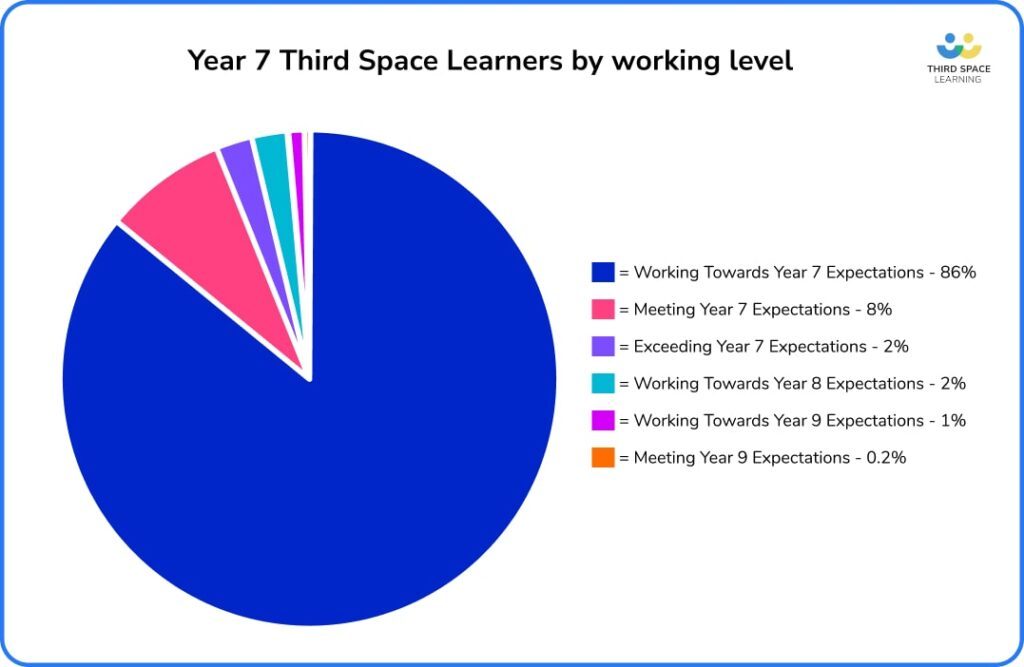High Attaining Disadvantaged Pupils: Why Do They Fall Behind And What Can We Do To Stop It?
At the end of June, The Sutton Trust published a report looking into high attaining disadvantaged pupils – specifically the progress they make between finishing primary school and sitting their GCSEs when compared to their peers.
The report, titled Social Mobility: The Next Generation – Lost Potential at Age 16, has found that, by the time they reach their GCSEs, they have fallen significantly behind.
In fact, they are three times more likely to fall out of the top third of attainers by the time they reach Key Stage 4, compared to their most affluent peers.

In this article, we’ll provide a summary of The Sutton Trust’s key findings, explore what this means for maths in particular, and outline what can be done to ensure these students receive the support they need to fulfil their potential.
- Disadvantaged high attainers: a forgotten cohort?
- Disadvantaged high attainers make less progress than the average student
- Which students are most at-risk?
- Maths interventions are critical
- Mindset is affected as well as academic attainment
- Fewer opportunities at home and at school
- Subsidised tutoring plays a key role in fulfilling potential
- What can schools do to ensure every pupil fulfils their potential?
Disadvantaged high attainers: a forgotten cohort?
In every school, decisions must be made about which pupils need additional support. The reality is that there aren’t always enough resources to meet the needs of every pupil identified.
When these kinds of decisions need to be made, disadvantaged high attainers might not always be top of the list – especially when their KS2 data suggests they’re on track to succeed at secondary.
Lower attaining pupils are more likely to receive catch-up tutoring at school, and pupils from more affluent backgrounds are more likely to receive additional support funded by their parents and carers.
High attaining disadvantaged pupils are caught somewhere in the middle.
But, as The Sutton Trust have found, this means this cohort falls behind. As they put it, their talent is ‘squandered’.
“Addressing these gaps should be a national priority, with a long-term plan in place, based on evidence. This should include closing the gap at all levels of attainment, and not just the lowest attainers.“
Social Mobility: The Next Generation – Lost Potential at age 16, The Sutton Trust
The Senior Leader’s Guide to Pupil Premium
Download this free guide for a summary of all the information you'll need. Includes information on budget decisions, reporting and accountability of Pupil Premium allocation.
Download Free Now!Disadvantaged high attainers make less progress than the average student
The Sutton Trust looked at a cohort of pupils who were in the top third of attainers at the end of KS2 and were eligible for Free School Meals at secondary school.
It found that disadvantaged high attainers have lower progress 8 scores than the average student; in other words, they make less progress.
According to The Sutton Trust:
- Each of their GCSE grades are more than three quarters of a grade lower than the grades of other high attainers and a full grade lower than those from the most affluent backgrounds
- They are twice as likely to drop out of the top third of attainment; rising to three times as likely when compared to their most affluent peers
- 40% of disadvantaged high attainers achieved grade 7-9 in 5 or more subjects, compared to 62% of non-disadvantaged high attainers
“If the disadvantaged group progressed at the same rate as their peers, there would have been almost 7,000 more achieving top grades. Over five years, this amounts to over 28,000.“
Social Mobility: The Next Generation – Lost Potential at age 16, The Sutton Trust
Which students are most at-risk?
According to the report, some students are more likely to fall behind:
- Boys
- White and Black Caribbean pupils
- Pupils with Special Educational Needs
- Pupils in the North East
Maths interventions are critical
While the report didn’t focus specifically on maths, rather just those pupils who had finished primary school within the top third of attainers in English and maths and their academic performance at secondary, we know from previous research that maths is a particularly critical subject.
Recent research from the Centre for Education and Youth found that:
- Maths is the subject where the link between KS2 performance and eventual GCSE performance is the strongest
- Maths has been the most affected subject in terms of post-pandemic learning loss
- Pupils are less likely to receive maths tutoring than English
- Maths anxiety has adverse long-term consequences for academic and professional success
- Maths is the subject in which achieving one grade higher results in the biggest impact on future earnings
“Our new analysis shows the strength of the relationship between maths performance at Key Stage 2 and pupils’ eventual results at GCSE level – a connection that is stronger in maths than other subjects. This means pupils who are behind in maths at primary school will find it harder to catch up with their peers by age 16 than those who are behind in other subjects, such as English.”
A Space for Maths, The Centre for Education and Youth
It’s clear to see that – across all cohorts – maths interventions have high potential to shape pupils’ eventual academic and professional outcomes. When looking at tutoring disadvantaged students who are also high attainers, they could be absolutely vital.
Tutoring Funding Summary: Downloadable guide for SLT
Tutoring Funding Calculator – see exactly how much funding your school will receive in 2024/25:
Mindset is affected as well as academic attainment
As we’ve seen with the role maths anxiety plays, it’s not just academic attainment that suffers. The change in pupils’ experiences and attitudes goes beyond maths anxiety.
This cohort of pupils has seen that they can achieve high grades, and yet:
- Disadvantaged high attainers were more than twice as likely than other high attainers to agree with the statement ‘people like me don’t have much of a chance in life’
- 65% of disadvantaged high attainers think they will be studying in two years’ time, compared to 75% of other high attainers and 85% of private school students (across all attainment levels)
- They were more likely to report that the pandemic has made them less motivated to study than other high attainers
Fewer opportunities at home and at school
Planning and prioritising interventions is a huge challenge for all schools. Understandably, it is often lower attainers who most often receive additional support and learning opportunities.
Just 26% of high attaining disadvantaged pupils have received catch-up tuition funded by the school, compared to 34% of other FSM pupils.
This is something we see as a maths tutoring provider for schools. The majority of pupils we work with are eligible for Pupil Premium, but when looking at our most recent cohort of pupils on the Year 7 Programme, only 6% were identified as ‘high attaining’ by their school prior to starting tutoring.

On the other side of the spectrum, their more affluent peers are more than twice as likely to receive private tutoring. In addition, disadvantaged high attainers are more than three times more likely to lack a suitable device to study at home.
For other high attainers, 91% of their parents said they ‘always’ talk to them about their school progress – this drops to just 75% for disadvantaged high attainers.
The barriers faced by disadvantaged young people do not simply disappear just because a pupil has shown high academic potential at the end of KS2; they’re still just as in-need of additional opportunities as their school can provide to truly fulfil this potential.
Clearly, every school wants to provide all the opportunities that their pupils’ need, but it’s a rare school that can afford to do so.
That’s where additional funding comes in…
Subsidised tutoring plays a key role in fulfilling potential
The report highlights the association with catch-up tutoring as part of the National Tutoring Programme (NTP) (both one-to-one and small group) and better performance in GCSE TAGs.
But in 2023/24, NTP funding is set to decrease. Schools will be able to use their funding to cover up to 50% of the costs of tutoring, compared to 60% in 22/23, 70% in 21/22, and 75% in 20/21.
One of the key recommendations in the report – one that is aimed at policymakers – is that the National Tutoring Programme (NTP) ‘should be seen as a core part of the school system going forward, with delivery re-focused in the long term to tackle the attainment gap’.
“While the government has recently reduced a planned cut to the subsidy for the programme in 2023/24, in the longer term, central funding must increase to be sufficient for schools to embed the NTP into their provisions.“
Social Mobility: The Next Generation – Lost Potential at age 16, The Sutton Trust
As well as urging policymakers to extend the NTP and ensure tutoring is as affordable and accessible as possible for schools, the report also suggests that schools identify and track highly able students, and ‘provide additional targeted support for those who have previously achieved highly but are falling behind’.
For those students, it’s essential that structured tutoring programmes through the NTP are accessible, and not just offered to their lower attaining peers.
As the most affordable DfE-approved one to one Tuition Partner, we speak with schools every day who are looking to maximise the funding they have to ensure they can reach as many pupils as possible. We help them provide personalised one to one support for multiple pupils at once, without the price tag or additional workload of traditional one to one support.
What can schools do to ensure every pupil fulfils their potential?
As well as their recommendations for the Department for Education to increase NTP funding and for schools to track their high attaining disadvantaged pupils and intervene with NTP tutoring when required, The Sutton Trust also make a series of other recommendations for schools:
- Prioritise ongoing testing over teacher identification when identifying high attaining disadvantaged pupils
- Consider designating a team of ‘highly able coordinators’ who have collective responsibility for this group and ensure all staff receive appropriate training
- Use Pupil Premium funding to support highly able disadvantaged pupils
- Because identifying this cohort can be difficult, consider making interventions that benefit highly able pupils accessible to pupils of all socio-economic backgrounds
- Adapt the level of challenge according to pupils’ needs and use teaching assistants to support with stretch activities
- Use setting with caution so as not to ‘harm the attainment of students in lower sets’
- Engage families, guardians and communities in interventions
“Underachievement at this level is likely to hold these students back even further through post-16 education and beyond, when they are competing against peers from more affluent backgrounds for university places and graduate jobs. Without adequate intervention, the social mobility of the next generation is under threat.“
Social Mobility: The Next Generation – Lost Potential at age 16, The Sutton Trust
Without suitable support, disadvantaged high attainers tend to fall behind their peers. There needs to be a clear national strategy to support schools to close the attainment gap. Improved funding is one route towards this, however it is also vital that schools use their funding wisely to deliver intervention strategies that make real impact.
Read more about effective intervention strategies:
DO YOU HAVE STUDENTS WHO NEED MORE SUPPORT IN MATHS?
Every week Third Space Learning’s maths specialist tutors support thousands of students across hundreds of schools with weekly maths tuition designed to plug gaps and boost progress.
Since 2013 these personalised one to one lessons have helped over 150,000 primary and secondary students become more confident, able mathematicians.
Learn about our experience with schools or request a personalised quote for your school to speak to us about your school’s needs and how we can help.





